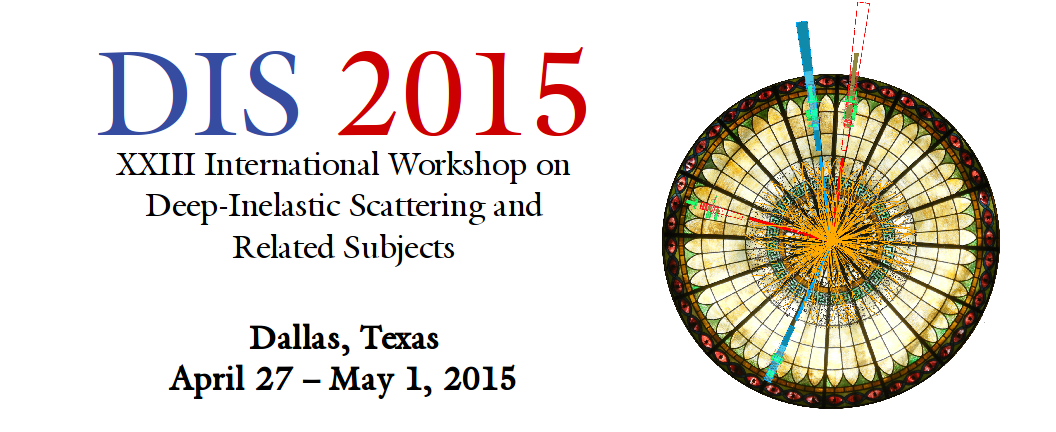Sanghoon Lim
(Yonsei University)
28/04/2015, 08:30
WG5 Heavy Flavours
Charm and bottom quarks are formed predominantly by gluon fusion in the initial hard scatterings of heavy-ions at RHIC, so they are good probes of the full medium evolution. In order to further understand the heavy quark dynamics in the hot medium, it is essential to study modifications due to the intrinsic nuclear matter so called cold nuclear matter effects. Deuteron(proton)-gold collisions...
Prof.
Zhenyu Ye
(University of Illinois at Chicago)
28/04/2015, 08:55
WG5 Heavy Flavours
High precision measurements of open heavy flavor production in p+p collisions are instrumental to test the validity and constrain the parameters of perturbative QCD (pQCD) calculations. Heavy flavor quarks are also suggested as excellent probes to study the properties of the hot and dense nuclear matter created in high-energy heavy ion collisions. In this talk, we present the most recent...
Dr
Deepa Thomas
(ALICE Collaboration)
28/04/2015, 09:20
WG5 Heavy Flavours
In hadronic collisions, heavy quarks (charm and beauty) are produced in hard scattering processes with large momentum transfer. The measurement of the production cross sections of heavy-flavour hadrons in pp collisions provides an important test of pQCD calculations. Some insight into the role of multi-parton interactions (MPI) and the interplay between hard and soft mechanism for particle...
Karol Kovarik
28/04/2015, 09:45
WG5 Heavy Flavours
We present a comparison of NLO QCD predictions for heavy-quark production
at the LHC. We compare theoretical predictions obtained with POWHEG to different predictions where fixed-order calculations are extended with next-to-leading logarithms and to predictions using the GM-VFNS. We focus on the productions of neutral and charged D mesons in proton-proton collisions at ALICE in an attempt to...
Justas Zalieckas
(University of Bergen (NO))
28/04/2015, 10:45
WG5 Heavy Flavours
We present the latest results from the ATLAS experiment on
B-hadron production, including the Bc+ production cross-section
measurement, observation of the B_c(2S) state, branching ratio
measurement of B_c->J/psiD(\*) decay and extraction of fragmentation
fractions fs/fd via reconstructed Bs->J/psiPhi and Bd->J/psiK* decays.
Marcin Chrzaszcz
(University of Zurich (CH), Polish Academy of Sciences (PL))
28/04/2015, 11:10
WG5 Heavy Flavours
An overview of the latest LHCb results on rare b and c-hadron decays is presented
Mohammad Ahmady
(Mount Allison University)
28/04/2015, 11:35
WG5 Heavy Flavours
We use the light front wavefunction for meson bound state obtained from holographic anti–de Sitter/chromodynamics to calculate the distribution amplitudes (DAs) for $\rho$ and $K^*$ vector mesons. Consequently, these DAs are utilized to compute the form factors for $B\to\rho ,K^*$ transition via light cone sum rules. Our predictions for semileptonic and rare B decays are compared with...
Jonathan Wilson
(University of Michigan)
29/04/2015, 08:30
WG5 Heavy Flavours
One of the most intriguing measurements in particle physics in recent years is the forward-backward asymmetry of top quark production. Although calculations at next-to-next-to-leading order have largely resolved the anomaly, these measurements are still very interesting as precision tests of the standard model and of physics beyond the standard model. We summarize the results on the top...
Serban Protopopescu
(Unknown)
29/04/2015, 08:55
WG5 Heavy Flavours
Measurements of the inclusive top quark pair production
cross sections in proton-proton collisions with the ATLAS detector at
the Large Hadron Collider are presented. The measurements are
performed requiring one or two electrons or muons in the final
state. Various experimental techniques are compared. The most precise
result requires opposite sign electrons and muons and uses the...
Nikolaos Kidonakis
(Kennesaw State University)
29/04/2015, 09:20
WG5 Heavy Flavours
I present a calculation of approximate N$^3$LO corrections from NNLL soft-gluon resummation for differential distributions in top-antitop pair production in hadronic collisions. I show that soft-gluon corrections are the dominant contribution to top-quark production and closely approximate exact results through NNLO. I show aN$^3$LO results for the total $t{\bar t}$ cross section, the...
Christian Schwanenberger
(Deutsches Elektronen-Synchrotron (DE))
29/04/2015, 09:45
WG5 Heavy Flavours
The large centre-of-mass energy available at the
proton-proton collider LHC allows for the copious production of top
quark pairs in association with other final state particles at high
transverse momentum. The ATLAS experiment has measured several final
state observables that are sensitive to additional radiation in top
anti-top quark final states. Results on the top production...
Jasone Garay Garcia
(Deutsches Elektronen-Synchrotron (DE))
29/04/2015, 10:45
WG5 Heavy Flavours
Measurements of the inclusive top quark pair production cross section at 7 TeV and 8 TeV are presented, performed using CMS data collected in 2011 and 2012. The total cross section is measured in the lepton+jets, dilepton and fully hadronic channels, including the tau-dilepton and tau+jets modes. Indirect constraints on both the top quark mass and alpha_s are obtained through their relation to...
Joseph Michael Izen
(University of Texas at Dallas (US))
29/04/2015, 11:10
WG5 Heavy Flavours
The existence of the X(3872) suggests the presence of its bottomonium counterpart X_b. Search for X_b with the ATLAS experiment
in several final states, including Upsilon pi pi, is presented.
Paolo Gunnellini
(Deutsches Elektronen-Synchrotron (DE))
29/04/2015, 11:35
WG5 Heavy Flavours
Measurements of the differential cross sections for the production of at least four jets, two of them initiated by b-quarks, in proton-proton collisions are presented as a function of the transverse momentum pt and pseudorapidity eta, together with the correlations in azimuthal angle and the pt balance among the jets. The data sample was collected in 2010 at a center-of-mass energy of 7 TeV...
Matthew Wing
(UCL)
29/04/2015, 12:00
WG5 Heavy Flavours
The photoproduction of $D^{*\pm}$ mesons has been measured with the ZEUS detector at HERA at three different $ep$ centre-of-mass energies, $\sqrt{s}$, of 318, 251 and 225\,GeV. For each data set, $D^{*\pm}$ mesons were required to have transverse momentum, $p_T^{D^*}$, and pseudorapidity, $\eta^{D^*}$, in the ranges $1.9 < p_T^{D^*} < 20$ GeV and $|\eta^{D^*}|<1.6$. The events were required...
